
The Race for Student Outcomes
It’s no secret that institutions are on a crusade to improve student outcomes. The reasons and motivations are varied. It can be for reputational, funding, or even competitive purposes, but it is clear that this new student success mandate is here to stay. What is less clear, however, is how institutions will go about achieving it.
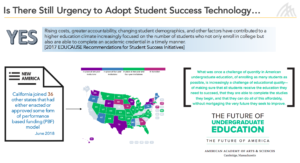
Student Success Strategy at PeopleSoft Institutions
In a new Leadership Briefing, we describe the popular big data and predictive analytics approach that some institutions are currently endeavoring to improve results. The report outlines an alternative approach specifically available to PeopleSoft institutions that is delivering measurable improvements with less risk.
Read full report: Leadership Briefing: Improving Outcomes for PeopleSoft Institutions
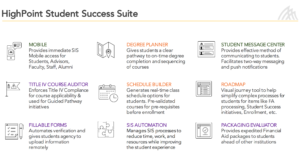
While some are experiencing slight improvements with predictive analytics projects, there are still cautionary notes about their early use and approach as reported in New America’s The Promise and Peril of Predictive Analytics in Higher Education.
As an alternate path, HighPoint has developed a unique approach to improving the student and administrative experience across campus. Rather than integrating external systems, transferring student information outside the institution, or gambling with predictions, HighPoint solutions work from inside the SIS to provide the functionality, accessibility, and contemporary experience that matters most to students and the administrators that support their journey.
Applying a “procedural” method that uses a combination of design-thinking, behavioral science, and an outcomes orientation in software development can achieve transformative outcomes with little disruption to current systems and workflows.
The HighPoint approach incorporates three concepts that drive outcomes for client institutions:
- Design the user experience for what students need and want
- Automate time-consuming & repetitive processes for back-office staff
- Deploy tools that deliver impact across departments, simultaneously
You can learn more about the Student Success Module and available configurations for PeopleSoft institutions via the new Leadership Briefing…

The Push for Guided Pathways
Guided Pathways Gaining Traction
Guided Pathways is not a particularly new idea, but it is rapidly becoming the buzzword for universities and colleges attempting to improve student outcomes. With graduation rates remaining stagnant and funding dollars directly tied to this key metric, institutions are doing everything they can to move the needle.
One of the biggest challenges higher education students face is financial limitations. They rightly save and budget for what they believe their education will cost. If they didn’t consider all of the extraneous costs and/or enroll in courses that aren’t necessary or do not qualify for financial aid, they can quickly find themselves in over their heads. Some students often traverse through a portion of their educational journey before realizing their savings are depleted. In order to complete their degree requirements, they will have to pay for an entire extra year they didn’t bargain for, thus leading to dropouts.
Guided Pathways is an initiative to solve some of the biggest pain points students (and therefore, institutions) have – those roadblocks that contribute to students giving up and leaving school before they’ve reached graduation. By laying out the most efficient path towards graduation, step by step, and providing the needed support along the way, institutions hope to boost student success by improving outcomes.
A National Crisis?
California is an example of one state that is taking Guided Pathways seriously. According to an article from EdSource, California had 2 million students in the state’s community college system in 2016 and just 48 percent of them left with a degree or certificate, or transferred after six years. California’s community college board plans to leverage the Guided Pathway concept to help its 114 community colleges in 72 districts reach several lofty goals:
- Increase the number of community college students who acquire associate’s degrees, specific skillsets, credentials or certificates “that prepare them for an in-demand job” by 20 percent in five years.
- Increase the number of community college students transferring annually to a University of California or California State University campus by 35 percent in five years.
- Increase from 60 percent to 69 percent the number of students completing career and technical education programs who get jobs in their fields of study.
- Reduce the number of course units students accumulate before earning associate’s degrees from 87 to 79.
Why the urgency? By 2030, California reports it will need 1.1 million additional workers with bachelor’s degrees to remain economically competitive – just the motivation the board needs to jump on the Guided Pathways bandwagon.
California isn’t alone in recognizing the future needs of its state. A CareerBuilder study discovered that 61 percent of hiring managers across the country are requiring higher-level education to fill their skilled positions. Similarly, new research from Georgetown University’s Center on Education and the Workforce recently found 55 percent of well-paying jobs in today’s economy are going to workers who have four-year or associate degrees.
“Americans with no more than a high school diploma have fallen so far behind college graduates in their economic lives that the earnings gap between college grads and everyone else has reached its highest point on record.” – CBS News
Higher learning institutions are the breeding ground for our economy. Without these higher education degrees and skills, the nation will become less competitive, less innovative and less able to fill the positions of tomorrow.
3 Things to Know about Guided Pathways
A Guided Pathway program may not solve every challenge of improving student outcomes, but it is giving higher education institutions a reason to be optimistic. By providing students with clear roadmaps, creating on and off ramps for their success, and establishing a support system at every level of their journey, students and institutions are experiencing much greater success rates.
Related: Shifting Perspectives: Guided Pathways and On-Time Graduation
There is plenty to understand about Guided Pathways, but here are three critical elements to help shape your perspective:
1. The pathway is individualized per each student’s needs.
Every student comes to school with different needs, life situations and goals. Their Guided Pathway should be just as unique. It should not be a one-size-fits-all solution, while at the same time, institutions don’t need to recreate the wheel for each student. Implement a set of standardized processes and technologies that provide the foundation for which customized paths can be designed. For instance, full-time students will have a different roadmap than part-time students holding down a job or caring for a family.
2. The pathway is not set in stone.
Just as in life, circumstances frequently change. Things don’t always follow a plan. Guided Pathways are flexible, meant to enable students to visualize and conceptualize a multitude of possible routes to their end goal of graduation. The best pathways offer students the ability to play “what if” scenarios so they can see how taking a course (or not) will impact their goals, budgets and timelines. They can play around with their schedules and sequencing of courses. The key is that the pathway is intentional, focused and informative – giving the student everything they need to make the best decisions for themselves.
3. The pathway is not remote.
A student’s educational journey is complex. They need support, resources and services to help them through each step. From admissions to financial aid, from course enrollment to degree planning, students need advisors, technology and access to information. The more they are connected to their institutions and the easier those connections can be had, the greater the chances students will flourish. Students should never get lost or feel alone during their journey. Schools must partner with students to get them from point A to point B, even if it’s vis a vis point C.
Start with Students in Mind
Whichever way you approach guiding your students through their pathway of education, be sure to keep them first. Design programs and support services around their needs and what specifically they require in order to be successful.
Is it streamlining and easing the financial aid process? Will providing them real-time access to their financial aid and course eligibility information be a benefit? Would equipping students with mobile access to perform most of the many required administrative tasks save them time? How would sending students push notifications to remind them of upcoming due dates impact follow-through? Would identifying at-risk students early on and then providing the necessary support to get them back on track improve outcomes?
These are but a few of the advantages a solid Guided Pathway program can bring students while enabling institutions to be more responsive to student needs. Take a look at available and emerging technologies to discover how your institution can deliver more than just lip service but a truly guided pathway towards graduation.

What Are You Doing to Make Financial Aid More Accessible?
The Financial Aid Myths
There are plenty of myths circulating around financial aid. One is that financial aid is hard to qualify for, even if you are low income. Another is that high school students are aware of college financial aid opportunities. Yet another is that institutions will help students properly complete their financial aid applications.
First, financial aid dollars are there for the taking, but it comes with the assumption that the forms will be completed perfectly and turned in on time. Second, many students have no idea about financial aid or what they need to do to find those dollars. Third, most institutions do not have the resources to help students complete their forms or notify them if they didn’t complete their forms properly. Let’s get into the data to see the ramifications of these misconceptions.
Money, Money Everywhere
A recent article published by EdTech Times highlighted a concerning issue around financial aid: many students fail to receive financial aid not because they do not qualify but because they didn’t complete the forms properly or turn them in on time. This is an unfortunate side effect of complicated forms that come with little direction and no timeline to help students know exactly when the forms are due. It doesn’t have to be this way. We’ll get to that after we present a few sobering facts.
One of the studies the article references is from the National College Access Network. This report found half of the low-income high school graduates surveyed had not applied for financial aid simply because they were uninformed about what financial aid was. Either the students don’t understand financial aid is available or they are intimidated by the financial aid process.
To their credit, the current financial aid process isn’t simple. It’s complicated and requires a lot of information that must be inputted in an exact format and submitted within a certain timeframe. Many high schools lack the counseling to inform students of their options. Even those that do may not have the man hours available to ensure every potential qualifying student has the information they need to complete the forms as required. The complexities of financial aid applications lead us to another interesting statistic.
NerdWallet estimates $2.7 billion (yes, you read that right) in FAFSA Pell Grant funds were never allocated to students in 2016 because the applications were incomplete. With the cost of tuition rising, this is a shame. There is money to be had, yet there is little education around its availability and even less about how students need to complete the forms. Students are left to figure it out themselves, which often never happens.
It’s A Matter of Resources
If higher education institutions had the resources, they would be able to quickly identify those applications with missing or incorrect information. They would have the personnel to track down the student and/or family members to inform them of the mistakes – in plenty of time for them to make the corrections and resubmit.
Unfortunately, those resources are nowhere to be found – at least not at most colleges and universities. It can take a financial aid office months to go through all of the incoming FAFSA forms and even longer to locate each applicant to walk them through their mistakes. Oftentimes, students aren’t ever contacted, never learning that only a few missing items on their forms caused them to miss out on available dollars to help pay for their dreams.
Related: Shifting Perspectives: Financial Aid Efficiency and Compliance
These dreams are often never realized because students incur so much debt, they become discouraged and drop out. They simply cannot continue with their educational journey because the funds are not there to pay for it. Between room and board, books and living expenses, and of course, tuition, many students have no other choice but to get a job instead of pursuing graduation.
The policies and stipulations for financial aid are likely to remain constant. FAFSA is very clear about their stance on financial aid applications: “paper applications with errors or missing information will be returned for corrections; therefore, their processing will be delayed.” The length of these delays will be dependent on the institution catching the error and finding the resources to give the student notice.
Can we really deny students the opportunity to go to and complete a post-secondary education simply because there aren’t enough resources to get them through the financial aid process?
A Better Way
If we think about other areas of our lives, we can identify situations and technologies where we are instantly alerted of an issue. Take, for instance, using a gift card to make an online purchase. The website will ask for the gift card number so it can be redeemed. If even one number is mistyped, you will be notified immediately that the card was not accepted. It might even go so far as to tell you why – that the number inputted does not match their records or does not exist.
Higher learning institutions can do more to help students obtain the available FAFSA dollars that separate eager students from the degree they desire. By integrating the right technology into the FAFSA process, institutions can boost enrollment while giving students the support they need to realize their dreams.
How does it work? It’s all about automation. Automation is ideal for those repeatable, and somewhat basic information and processes. The financial aid process is just that. The forms are standard. The information is thorough but relatively basic. Identifying missing information is simple when the verification is automated. Contacting the students for missing information is sped up when the communication process is automated.
Related: Case Study: Seminole State College – Achieving Greater Success with Fewer Resources
Through automation, financial aid offices can relieve the burdens of form reviews, verifications and communications. They can free up their time to educate students about the availability of financial aid instead of going over every form with a fine tooth comb. Automation is not only faster and more efficient, but it is more apt to catch the errors and omissions. It also reduces the institution’s risk exposure when they pay for ineligible courses.
Institutions who have implemented such financial aid automation software have seen significant increases in financial aid application submissions, as well as increases in financial aid grants. Students are more informed sooner, so they have plenty of time to make corrections and resubmit before the deadline. They receive more financial aid dollars and can pay for more of their college expenses.
It isn’t rocket science. It’s taking the technology we already have and applying it to the traditionally labor-intensive process both students and financial aid offices no longer need to tolerate. The financial aid is there. It’s time to make it easier to get.

Shifting Perspectives: Financial Aid Efficiency and Compliance
The Financial Aid Grind
There’s something students and financial aid staff have in common: they both suffer from process overload. As much as students struggle to complete all of the paperwork and keep track of their course eligibility, financial aid offices are laboring over applications, disbursements, and documents in hopes of remaining compliant with the Department of Education’s requirements. It’s a continuous and exhausting treadmill of to-dos that never seems to ease.
Higher learning institutions do the best they can with the resources they have. Students try their hardest to complete their financial aid applications in time. Then, they wait. With so many applications coming in at once, it takes time to sort through them all, let alone find errors and omissions that require more input from the applicant. It can take months for the financial aid staff to recognize the missing information, track down the student to inform them and walk them through the corrections. Students can spend hours with the call center asking questions and getting help, costing the school thousands of dollars in support. Tragically, many students never get notified, understand why their application was declined or learn of their errors until after the deadline.
All of this drudgery and we haven’t even touched upon the issues with course eligibility. With many higher learning institutions, there are no safeguards to ensure financial aid students do not enroll in classes that fail to contribute to their degree requirements, thus become ineligible for financial aid. Classes are paid for without visibility into whether or not they qualify for financial aid, putting the institution at risk for noncompliance and hefty fees.
Related: New Administration, New Financial Aid Scrutiny
Many students enroll in ineligible classes because they are simply interested in the class and fail to realize the implications of taking an ineligible class. They have no degree roadmap or guided pathway to show them every class option they could take, in the order they should take them, to reach their degree requirements the fastest. Instead, they meander through the educational journey, taking longer than anticipated and racking up debt – both of which are the leading causes for dropout.
- 60% of four-year college students graduate within 6 years
- 1 in 3 students enrolled in community college will graduate within 3 years
- 31% of 22- to 30-year old college dropouts stated their major reason for leaving college was their inability to afford the education
- “Taking the wrong courses” ranked as the 6th most common reason students drop out of college
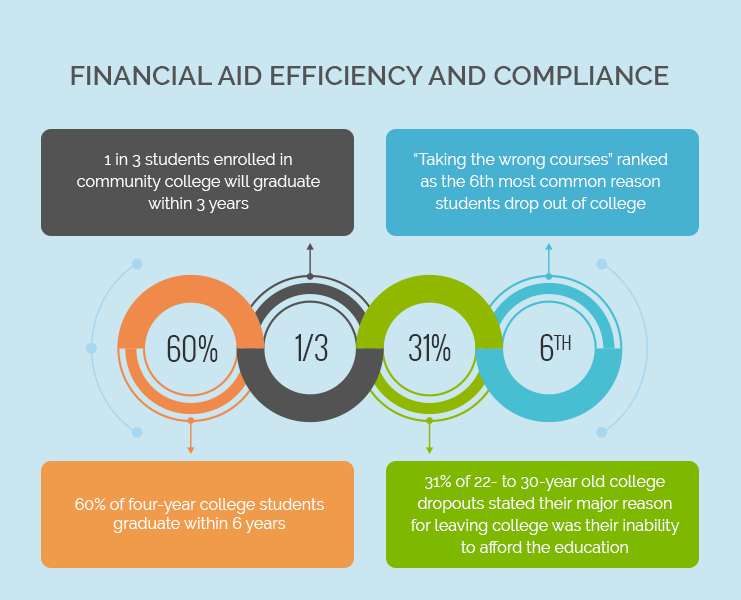
Because so many of today’s students work and have families, the financial burden of paying for their rising education costs is simply too much. In the balance of work, family and school, something eventually has to give. The harder financial aid is to manage and the more debt that is incurred, the more likely school will be the dispensable option.
Making It Easier for Students and Staff
Simplifying the application and financial aid management process would, of course, do wonders for the both the institution and the students, but how? With federal dollars and the Department of Education in the loop, it isn’t always easy to make improvements. Every application must be completed a certain way before it goes through the standard steps which require so much human interaction. Where there is repetition and standardized processes, there is always room for automation.
Automation via modern software technology is turning the financial aid process on its head. When steps can be automated, the burden of labor is lifted from staff so they can focus on other tasks. The process is faster, more fluid, and infinitely more efficient. Students and parents are empowered with sequential to-do lists, keeping them informed and organized.
Once the financial aid application is received by the institution, it is automatically uploaded into the ERP system and automatically verified for incomplete or erroneous information. The software notifies the institution if the application is complete and the student if there is something missing – within 24-hours of submission. Links to tutorials guide them on how to fix their problems themselves and complete their applications as needed.
When students have real-time access to the status of their application, they can enroll in courses with confidence, choosing only the courses they know will qualify for aid – or at least understand how their choice will impact their budget and graduation goals. Automation and access also give students the ability to map out their coursework semester-by-semester, seeing which course options would get them to their graduation goals the fastest. By taking only the eligible courses in the order they should be taken, students are more likely to stick to their plan and graduate on time and within budget.
Related: How Financial Aid Course Audit (FACA) Is Helping Students Get The Most Out of Financial Aid
Institutions can dramatically reduce their risk exposure through automation. It becomes simple, even basic, for a financial aid office to evaluate whether or not a student should be paid for a class. Ineligible classes can be flagged before students enroll. PeopleSoft, the SIS system of choice for many higher learning institutions, simply isn’t capable of performing a degree audit on every student. It takes another layer of technology to optimize PeopleSoft and automate the process.
The Marriage of Technology and Academics
Higher learning institutions have been relatively slow to break down the silos that often exist between IT and academics. Some schools are traditional and believe the programs, services and processes used in the past are sufficient for today. They are more hesitant to adopt newer technologies. This mindset, however, can be detrimental to the student and the institution.
When technology supports academic initiatives, and today’s students influence those innovations, real transformation occurs. Students are empowered to take control of their own educational journey, equipped with the information they need to stay on track and the technology required to enable them to do so. Institutions streamline processes, reduce labor and expenses, and contribute to the goal of every stakeholder – on-time graduation.
The more students who graduate on time, the more funding schools receive. The fewer dollars institutions must spend on resources to complete manual tasks, the more they can maximize that funding. Automation is the key. Without it, resources and dollars are wasted. With it, however, students and staff can do more with less.
The financial aid process doesn’t have to be so difficult. It can be, and must be, simplified and made more efficient. Students demand and deserve it. Institutions’ viability depends upon it. It requires a symbiotic relationship between academics and technology to make it happen.

Shifting Perspectives: Guided Pathways and On-Time Graduation
Are Guided Pathways The Key to Graduation?
When students enter their post-secondary journeys, they begin with the end in mind: graduation. They apply, enroll and begin their experience in the hopes that in two, four, or six years, they will graduate their program of study and move into the workforce prepared. They understand there are logical steps to get them from point A to point B, but few students set out with a detailed plan on how to navigate that journey.
Even though the expense of higher learning can be one of the largest investments in one’s lifetime, it’s rather amazing to see how ill-prepared students can be. If you were to plan a trip abroad, for instance, you would likely have a plan for every day of your trip. You would know the time and dates of your flights. You would have completed all of the necessary tasks to get your passport and currency exchange. You would have booked rooms at hotels, purchased tickets for museums, planned an itinerary for all of the sightseeing, and even researched the best restaurants along the way.
All of this planning is for a trip that may last a week or two and cost a few thousand dollars. Why isn’t the same care given to the much larger investment of time, money and energy in college? Much of the reason isn’t laziness or apathy; it’s twofold – students believe they will “figure it out along the way,” and that the institution they will be attending will help them.
This perspective isn’t always wrong, it’s just naive. Many schools lack the appropriate guidance capability or resources to hold every student’s hand along their higher learning journeys. They offer advisors to a limited degree, but there isn’t much structure or intentional processes in place to establish guided pathways for each student, particularly beyond their first year. The institution can offer support, but it’s generally student-initiated after the first year and can come too late.
“While students certainly make choices about enrollment based on personal circumstances, the many course and program options and the limited guidance currently provided by community colleges likely contribute to students’ meandering and varied pathways through college.” – Community College Research Center
More Structure and Support with Fewer Options
While the Community College Research Center is focused on community colleges, even four-year universities are taking notice of the problem. Both are adopting the guided pathway approach which provides a much more structured, relevant program for each student. These guided pathways promise to support the students whether the students seek out that help or not. It requires the different departments within the institution to work collaboratively and communicate more frequently so that students never “meander” but are highly focused on goals that set them up for on-time graduation.
Related: Guided Pathways Are Better Than Going at It Alone
Research backs up the claim that when students are given fewer options and more support, they do better. Here are a few findings:
- Having too many choices leads to indecision, procrastination, self-doubt, and decision paralysis.
- People handle complex decisions better if they are helped to think through options hierarchically, in manageable sets.
- Reminders, assistance and feedback can increase desired behaviors.
- Academic plans with defaults help students make course choices that will move them towards their goals, while still permitting them to customize their schedules.
- Monitoring student progress and giving them frequent feedback about next steps helps students make choices.
- Students benefit when they have clear learning goals and a concrete sense of how they are progressing towards those goals.
- Providing students with a big-picture overview and how courses fit together improves learning.
By implementing a guided pathway structure, one large university was able to:
- Improve year-to-year retention rates from 86% to 92%
- Improve four-year graduation rates from 44% to 61%
- Reduce students graduating with excess credits from 30% to only 5%
Students Need Help
The Advisory Board Company, a research and consulting organization including 800 member colleges and universities, identified four key issues when it comes to student success:
- Colleges and universities face new pressures to improve graduation performance.
- College students take too many credits and too long to finish.
- The traditional focus on first-year success misses the majority of the problem.
- Some schools are now focusing on progress, not just persistence.
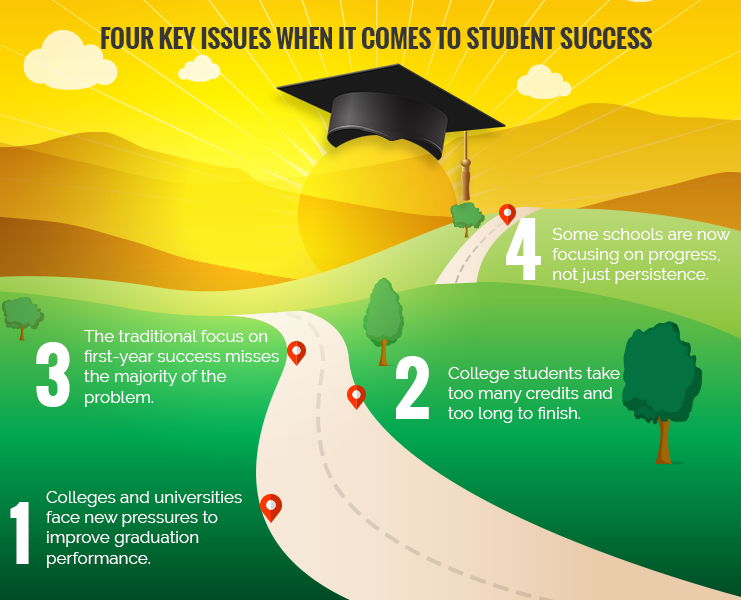
The strategies they note to guide progress:
- Maximize credit attempts
- Reduce lost credits
- Simplify course selection
- Preserve flexibility
The report also cites research showing the average student completes an unnecessary extra semester worth of courses, often due to issues stemming from a lack of sufficient advisement. These are credits students are paying for that do not contribute to their program of study, only to their student debt.
Give Students What They Need, When They Need It
Students need to be given the tools and technology that set them up to succeed from the beginning of their journey until they graduate. This includes the ability to map out their goals based on their program of study with realistic timeframes, costs and schedules. Like a detailed travel plan, no student should ever wonder what’s next.
Whether the student is young or old, full-time or part-time, they deserve to go into school with a clear understanding of their “trip.” There should be no confusion about exactly how many hours they need to take each semester, which courses are eligible for both their degree requirements and their financial aid, the order in which they should enroll in those courses, and how any deviation from their plan will impact their goals and their budget.
They should be able to easily build their schedules and monitor their progress, ideally via a degree map they can view on their mobile device. If students can access their specific road map on the device they carry with them and use multiple times a day, they are more likely to stay on top of their own journey. Asking them to schedule appointments with advisors to get anything accomplished only leads to the procrastination mentioned above. Mobile apps serve as their GPS, directing them step by step to their end destination.
Is Automation The Answer?
The cost of not implementing this type of technology is significant. The Advisory Board Committee found that the estimated cost of adding the number of advisors that would be required to support students in a similar way would cost anywhere from $0.5M for a small institution to nearly $2M for a large institution. How can institutions provide the level of structure and support students need without breaking the budget?
The more automation schools can bring to their processes, the more students can be helped with fewer required resources.
Higher learning institutions are in a tough spot, negotiating the pressure from the Department of Education, the desire to help students succeed and often limited resources. Institutions may find technology is a life raft. If they can strike a balance between technology and academics, they will be better positioned to offer students the academic support they need via programs and channels students now require.

Shifting Perspectives: Student Experience
Why The Student Experience Is Such A Big Deal
Higher learning institutions are intimately familiar with the “student experience.” They live and breathe it every day, understanding how their very existence is based on how successful their students are while in their schools. Thanks to the Department of Education’s Title IV mandates, schools with better student outcomes receive more federal dollars. While enrollment is still a concern, what happens to those students who are enrolled has taken center stage.
The student experience begins with the application and continues when the student graduates and becomes an alumna. Many of the school’s departments touch the student along the way – admissions, administration, financial aid, and advisor offices are among the most expected. Yet in order to provide the experience students of today now want and require, IT must get involved as well.
Technology can no longer be allocated only for back office processes, relegated to ERP and SIS applications, for instance. Students need their own accessibility and applications designed specifically for their unique requirements. An online student portal is just the beginning.
Related: College Access Is No Longer The Primary Focus
The Student’s Perspective
Many of today’s students have been raised on the kind of technology we have all become so accustomed to in our daily lives. TechCrunch recently reported smartphone users are using nine apps per day, 30 per month. Even older students may hardly remember a time without mobile phones, downloadable apps from the App Store, GPS, and social media. These technologies have given us the ability to do more from anywhere in the world.
Some higher learning institutions are still offering limited functionality from the campus technologies. They may have a fantastic online portal where students can check classes, grades, and hours of office operations, but no real way to engage with the school or become more self-sufficient. Students are still required to make appointments with administrators and advisors, stand in line to discuss financial aid issues, and wait for school staff to get them the information they need.
These efforts are counterintuitive to everything the students experience in their outside-of-school lives. They engage with friends and businesses via social media, messaging apps, and secure message centers. They complete tasks, such as paying bills, purchasing items to be delivered in two hours, and signing documents on mobile apps. They can reference a map on their mobile phones to find any location in relation to any other location, including their own. They can look up any question and within seconds, find answers.
Why shouldn’t their schools, the institutions in which they invest perhaps the largest amount of dollars in their lifetime, provide a similar experience? Why shouldn’t students have access to their information so they can design their schedules, choose and enroll in courses, add and drop courses, and check grades? Why can’t schools offer a better way to communicate with advisors, check their progress in reaching their goals, and manage their financial aid? And why shouldn’t an institution provide guided pathways to help students achieve the best outcomes?
Institutions can. But it’s going to require IT and student academics to come together to bridge the gap.
Related: Guided Pathways Are Better Than Going at It Alone
The Institution’s Perspective
It isn’t uncommon for an institution to believe they are offering all of the technology a student needs to succeed. The problem is, many times, this technology has hardly evolved over the past several decades. The schools may offer online portals and email, but they aren’t embracing the kinds of technologies students are increasingly using and expecting. To them, the student experience is more about offering a variety of course options and student-life activities, but it’s not focused on helping them be better students.
By giving students more access to their own information and providing them with the tools to do more on their own from the convenience of their mobile devices, schools stand to benefit as well. With fewer student appointments, advisors and administrators have time to develop programs to help students reach their goals.
Financial aid offices significantly reduce paperwork and risk when students receive automated alerts when they try to enroll in an ineligible course. Schools reduce costs and potential fines for non-compliance. Students stay on track towards graduation goals and end up spending less money to graduate on time. That is student success.
Giving students the technology they demand isn’t just about the student. It’s about efficiencies both student and institution can experience. Modernizing the institution to meet the needs of students as their demands evolve is smart. When students succeed, institutions succeed. This is no more apparent than with the current federal funding process which puts such a premium on student success.
Bringing Technology and Academics Together to Deliver Ultimate Student Experience
What is it going to take to modernize the student experience? It requires IT and academics to work side by side. Student affairs understands students and what they need to succeed. IT understands how to digitize the solutions required to meet those needs.
To optimize the student experience, students need options. An online portal is convenient for those students who use a computer. Email is ideal for those who check their messages. But not all students engage the same way. A mobile presence shouldn’t be an afterthought but a well-planned and designed solution that delivers a similar, if not better, experience than the online portal. It should be responsive, easy to navigate and use, simple to view, and fast. It should provide access to information, offer the ability to complete most tasks, and provide multiple communication channels.
Communication is a key element to any student success initiative. Many institutions are following the lead of banks who had similar issues with security via email. They now place sensitive customer messages and/or documents in a secure message center. The customer (or student, in this case) is notified via email and/or a push notification when there is a message in their personal message center.
Schools who use a message center can do something they struggle to do with email – track open rates. They can see exactly who has opened their messages and who has ignored them. They can then send follow-up reminders or attempt to reach students via other channels to ensure the message is read and acted upon.
Technology like this is what helps keep students on track to reach their goals. When students can receive push notifications reminding them of upcoming deadlines, they are more apt to complete the required task. When students can monitor their progress along an educational roadmap, they can see how course selection will impact their graduation timeline. When students can track financial aid payments and course eligibility, they can ensure they stay within their requirements and spend less money.
The student experience is twofold: academics and the technology required to manage their journey in a modern world. The institutions who deliver on both will be the ones who succeed with their students.

Shifting Perspectives: Student Engagement and Communications
The Importance of Student Engagement and Why It’s So Hard
You don’t have to look for long to find research on the importance of student engagement. Boiling it down, student engagement is often the difference between student success and student failure. Students who are more engaged simply do better. They are more likely to reach their goals and enjoy themselves along the way. Communication is a critical link to helping students become more engaged, as is the technology to empower them.
The Journal of College Student Development published an insightful study entitled “What Student Affairs Professionals Need to Know about Student Engagement.” In it, it cites another study that found “the amount of time and energy students put forth – student engagement – is positively linked with the desired outcomes of undergraduate education.”
The problem is many students are required to put in too much effort to do menial, administrative tasks. They are expected to schedule appointments with administrators, advisors, and financial aid offices and then wait in lines for their turn – that is, if they ever receive or read the communications intended to remind them. Many schools still depend on email and have no way of tracking whether or not the messages were sent, received, or opened.
For today’s student who is used to completing so many tasks instantly from their mobile phone, this process seems archaic and painful. For students who have families and/or jobs, this process is nearly impossible. For many, their educational journey becomes too labor-intensive to be worth it. For others, they stumble along constantly behind, missing deadlines, and incurring unnecessary costs.
Making Connections
Student affairs take student engagement seriously, yet are often handicapped if they don’t involve IT into their strategy. Two connections must happen. As good as their intentions, modern technology is the only way they can connect with students. Student affairs cannot work in a vacuum. Neither can IT. The two must connect and work together to solve the challenges of both the institution and the student. Student success is inextricably connected to institutional success.
Technological maturity is highly subjective. Implementing an ERP system may be a huge step forward to an institution who is trying to digitize business processes, but is all of that number crunching solving real problems? Is it helping the institution maintain performance-based funding? If graduation rates aren’t improving, capturing and processing data may not be enough.
The Technology-Student Engagement Connection
Decades ago, it may not have made sense to connect technology with student engagement. IT did their thing and students did theirs. Beyond setting up basic email, online portals and registration, and back office ERP and other systems, it was up to student affairs to engage students through activities. Today, however, is radically different.
These students cannot imagine life without technology. They carry mobile phones with them everywhere they go. In only seconds and from the palm of their hands, they can execute tasks, discover information, and find what they need. They don’t wait in line to pay their electric bills. They don’t go to a bank to deposit a check. And many of them do not regularly open emails. Perhaps this is why only 64 percent of first-year students indicate they frequently get prompt verbal or written feedback from faculty members.
If institutions want to truly engage and communicate with students, they will have to meet students where they are…and it shouldn’t be in a waiting room in an administrator’s office. It needs to be on the devices and through the channels students are using in every other part of their lives.
Institutions may not be able to remove all of the tasks and responsibilities students must complete throughout their educational journey, but they can – through technology – make them much easier and faster to check off their lists. By doing so, students are more apt to complete those requirements and stay connected with their school both during their years of study and beyond.
What Matters Most to Higher Learning Institutions?
Gallup asked 663 college and university presidents across the country “how important are each of the following factors in evaluating the success of a college president during his or her tenure at an institution?” Here’s what they rated as “extremely important” or “very important”:
- 96% – student retention rates
- 95% – ensuring graduates have the skills needed to find jobs in their chosen field
- 94% – student enrollment
- 93% – student graduation rates
- 92% – student engagement
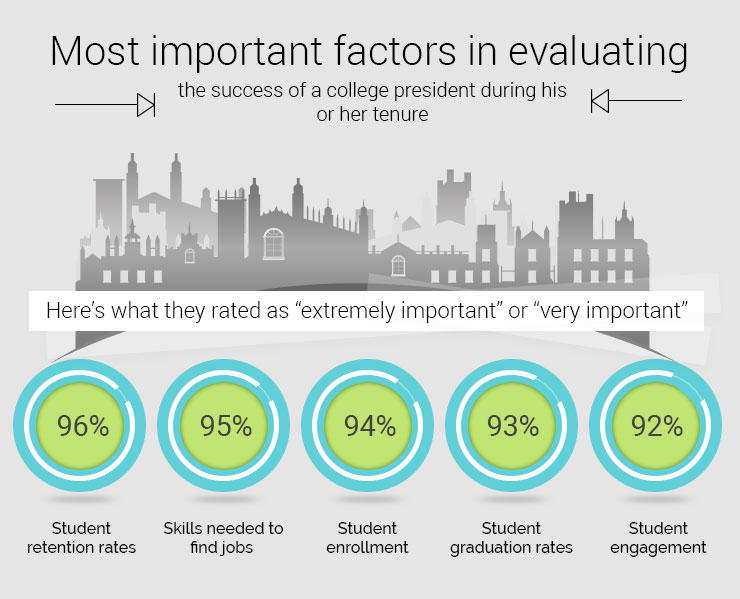
Here are the recommendations Gallup offers, based on the findings:
“Presidents should focus on helping students learn and practice what they do best, so they can build their engagement with school today and can land a great job and lead a purposeful, thriving life in the future. Doing some strategic asking and listening to students and graduates is a good place to start.”
How can a school help students learn and practice what they do best? How can they ensure student retention, graduation, and engagement? How can they boost enrollment and confirm students have required skills?
They can ask and listen to what students are demanding. They can provide them with the latest technology that students actually want to use to succeed – and the very technology they will be required to master in this modern world. From application submission through graduation and alumnae status, they should be able to complete tasks, monitor progress, pay fees, check statuses, communicate with staff, and find what they need from a mobile device. Why? Because this is how their world operates.
What Institutions Have to Gain
Traditionally, student affairs and academics have been focused on student success. IT typically doesn’t have much to do with students. This must change. In order for students to succeed and thus, institutions succeed, IT must have a seat at the table. They will be the ones to enable and empower students beyond what student affairs can do alone.
As campuses implement modern technology, more than just the student stand to benefit. Much of the technology required today is centered around automation. It’s through this automation of manually-intensive processes where institutions can gain significant, if not remarkable, efficiencies. Much of these processes are a series of repetitive, tedious administrative tasks that require massive amounts of time, effort, and manpower. Automation eliminates most, if not all, of it – all while improving accuracy and speed, and reducing errors, risks for non-compliance, and costs.
Modern technology also unlocks the data within ERPs and SISs, connecting the data so institutions have a more comprehensive, integrated profile of each student. This data is easier to access and helps advisors identify at-risk students faster. It gives administrators the ability to help students become more self-sufficient. It assists financial aid offices and students with paperwork and reminders. It helps students and staff communicate more effectively across the channels students are more likely to check – and gives staff a “paper trail” to track message open rates.
What technology is your institution using? Is it solving real problems your institution and students are facing? Is it giving students everything they need to succeed in today’s world? If not, the solution will be found in the balance of technology and academics.

Shifting Perspectives: Higher Ed Access to Student Outcomes
College Access Is No Longer The Primary Focus
Decades ago, higher learning institutions were out of reach for many. Access and affordability were the top concerns. Either the admission policies were too stringent, there were limited ways to pay for an education, or the costs simply out of reach. Many opted to immediately enter the workforce upon graduation and/or begin families.
So much has changed since then. Major shifts in enrollment, student demographics, and funding now require higher learning institutions to change course or be left behind. Much of the driving force behind this evolution is the fact that graduates are now competing for jobs with candidates from around the globe. A post-secondary education is no longer bragging rights but a requirement for the more desirable, higher paying jobs.
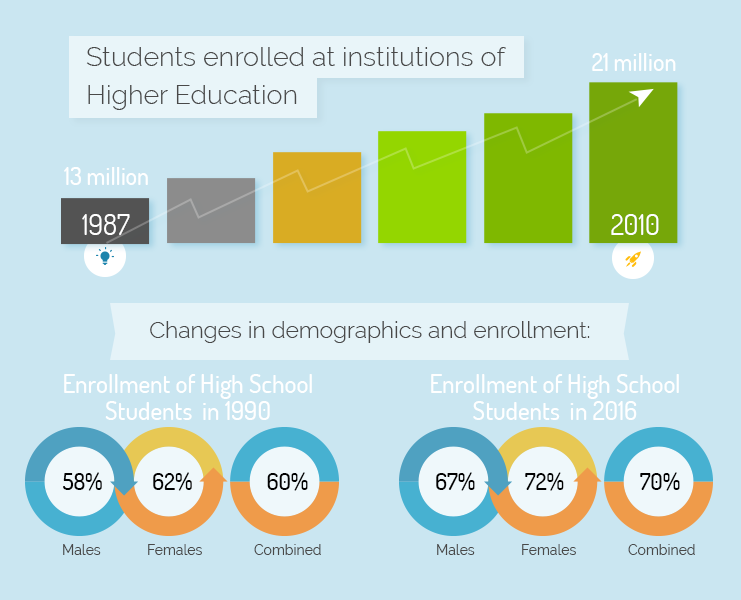
Clearly, accessibility is no longer a barrier to entry. Higher learning institutions are shifting their focus from providing access to student outcomes and success.
One of the most proactive and self-sustaining actions an institution can take is to bridge the gap between academics and IT. These typically siloed departments must work together to build the internal structures required to deliver the modern education students demand. These students have been raised on technology. They expect the institutions to whom they pay will prepare them for these jobs using the technology they are accustomed to in order to quickly perform tasks and monitor their progress throughout their educational journey. This is how students succeed. This is how institutions improve student outcomes.
Student Success Is The Driving Force
Today, it’s no longer a goal to boost enrollment numbers. With performance-based funding front and center, success rates have taken precedence. It’s pretty simple math: higher performing institutions get more funding than lower performing schools. How do we now measure performance? At the most basic level, it comes down to graduation rates.
Despite all of the efforts to improve student outcomes, it doesn’t appear they are having much effect. For students entering college in 2008, about 60 percent of them earned a bachelor’s degree within six years. For those entering college in 1996, graduation rates were just over 55 percent.
A five percent increase in graduation rates in more than a decade isn’t very impressive. Accessibility was a much simpler beast to tackle. What does it take to ensure more college students graduate and achieve the outcomes higher learning institutions so desperately need to push?
Many college systems put all of their eggs into the technology bucket, investing in giant ERP systems to digitize business processes and crunch numbers. While the data is being tracked and stored databases, little has been done with the information to move the needle.
That’s why increasingly more institutions are beginning to move beyond ERPs to focus on software to solve specific problems in order to maintain performance-based funding to simply survive. Most of the challenges they are trying to address are centered around student success – helping students graduate on time and within budget.
Balancing Admissions with Student Outcomes
There is a sweet spot for higher learning institutions. It lies somewhere between admissions and on-time graduation, and it involves both a change in perspective and an investment in modern technology.
The student population has changed nearly as drastically as the technology required to support them. Today’s college student is just as likely to be a mother, father, or full-time worker as they are a recent high school graduate. Students of all demographics are asking for flexibility, not simply accessibility. They want college on their own terms, on their own schedules.
Just as important is their desire to use the technology they are using in their everyday lives to navigate the post-secondary journey. For these tech-savvy students, standing in line to make a financial aid payment or to visit an advisor to drop a class is akin to referencing an encyclopedia for current information. It’s archaic, inefficient, and frustrating. They can do virtually everything on their mobile device…except perform the very tasks they need to succeed in college.
Students want to take control of their own journey and they expect to be able to do it from the mobile devices they carry with them everywhere they go. Yet, it’s more than just giving students a mobile app. It’s about giving them access to their student information so they have real-time insight to make decisions in their own interest and in their own time.
Higher learning institutions must put today’s student first, understanding where they are coming from, what they want and need to succeed. Most importantly, it’s realizing today’s student is vastly different from students even a decade ago. Institutions must meet students where they are if they truly want them to succeed.
4 Areas of Focus for Today’s Institutions and Students
When institutions combine the philosophy of “students first” with the technology to enable them, they position themselves and the student to maximize outcomes. Where should higher learning institutions concentrate their focus? When they commit to these four areas, everyone wins.
- Student engagement and communications
- Student experience
- Guided pathways and on-time graduation
- Financial aid efficiency and compliance
What does it take for an institution to be student-ready? The academic side of the institution must come together with the technology side. Both must recognize their dependence on each other to bring the institution into modernity – to give students everything they now require, not simply want, to achieve the best outcomes. Student success, necessary funding, and long-term institutional viability are riding on it. In a nutshell, the investment is worth it.
Technology and academics can be (must be) combined in a smart way to give students the ability to make their own decisions. Students want to have a voice. They are spending tens of thousands of dollars for an education they believe will prepare them for today’s workforce. If the institution isn’t providing the latest technology, how can they possibly graduate workforce-ready students?
In a series of upcoming blogs, we will discuss in detail each of these four areas institutions must master if care at all about student success. Each area is critical to providing the best user experience so we plan to guide you through it without bias.
This is where education is heading. This is where we will finally see graduation rates improve beyond 60 percent. It’s time to modernize college campuses to give students the tools they need to succeed in today’s competitive market. When students succeed, institutions succeed. It’s a win-win, but it requires buy-in from both academics and IT. We’ll show you how to build the synergy you’ll need to make it a reality.

Guided Pathways Are Better Than Going At It Alone
What Are Guided Pathways?
Higher learning institutions are hearing quite a bit these days about guided pathways. According to Community College Research Center (CCRC), “College students are more likely to complete a degree in a timely fashion if they choose a program and develop an academic plan early on, have a clear roadmap of the courses they need to take to complete a credential, and receive guidance and support to help them stay on path.”
This sounds logical and straightforward, yet some schools struggle with this prescription. Community colleges, in particular, can find it challenging to break out of their “cafeteria” approach. They often present students with a host of course options without regard to how these courses are related or will fulfill degree requirements. While students may see the multitude of options as attractive, they are not aware of how easily these options can derail their graduation and budget plans.
“Having too many choices leads to indecision, procrastination, self-doubt, and decision paralysis.”¹
When students choose courses like they’re filling a plate from a buffet, they often pick courses that look good but won’t count towards their degrees and aren’t eligible for financial aid. Their plates are full and they can even eat dessert first, but when they get to the end of their meal, they realize they paid for more than they could eat and much of the food will be tossed in the trash.
This is no way to approach perhaps one of the largest investments in a student’s life. Once they choose a degree focus, they should understand exactly what courses they are required to take, which will get them closer to their degree goals, and which order they should take them for maximum efficiency. This is what student success is all about. This is the intent of a guided pathway.
Related: How Do You Define Student Success in 2017?
How Can Institutions Provide Guidance?
Higher learning institutions want to provide students with a wide range of course offerings. This is understandable and helps these schools remain competitive. While there is nothing inherently wrong with expanding course offerings, institutions have an obligation to help their students navigate such a dizzying array of options.
Students, particularly the younger students with little independent life experience, can be easily distracted by shiny courses that peak an interest or sound interesting. There may be a place for those courses somewhere in the student’s journey but they should at least understand how taking the class may impact their overall goals and budget. They can then determine whether it’s worth it to them to enroll or if they should stay on their structured path.
“A simplified set of options that includes clear information on costs and benefits – or the provision of a “default option” – can help people make more optimal decisions.”²
Advisors can work with students to choose a program of study, devise a plan, and build their schedules. They can provide students with highly structured roadmaps that visually depict the most efficient route a student can take to achieve their academic and career goals while keeping their budgets in mind. Students can check in with these roadmaps to see how they are progressing and to conduct “what-if” scenarios to see the detour that rogue class might present.
CCRC suggests three key features of a successful guided approach:
- Clear road maps to student end goals – academic goals are clearly mapped out by faculty to create educationally coherent pathways with clearly defined learning outcomes that are aligned with requirements for further education and, in occupational programs, for career advancement. Students are given a default sequence of courses to follow for their chosen programs based on maps created by faculty, although they can still opt out to follow an alternative path. Rather than restrict students’ options, the guided pathway approach is intended to help students make better decisions so that they will be more likely to achieve goals.
- On-ramps to programs of study – mechanisms are in place to help new students develop or clarify goals for college and careers and to create an academic plan that shows a recommended sequence of courses that students should follow to complete their programs.
- Embedded advising, progress tracking, feedback, and support – students’ progress relative to their academic plan is tracked, and frequent feedback is provided to them and their advisors and instructors. “Early-alert” systems signal when students are struggling, and they set in motion appropriate support mechanisms.
Even with such guidance, there will be students who will fall into the “at-risk” category. They will need additional support which begins with early detection. These red flags should be automated, particularly at the larger schools who do not have the capacity to watch every student.
An early warning system may flag a student who is consistently late in completing required tasks, such as financial aid payments or course registration. Students who are hovering between passing and failing a class, especially those required classes, should receive early intervention before it’s too late. A system should be in place to alert administrators of students who are taking courses that do not qualify for financial aid – before they’ve paid for the course and purchased the books.
This level of intervention will require personnel, of course, but also modern technology. Automation is key. Higher learning institutions can not rely on outdated systems, manual entries and cross-checks, or homegrown applications that are slow to scale. They can also do more to give students the ability to monitor their own progress on their mobile device. Students are always on the go and want access to instant information. Allowing them to register for courses, verify class eligibility, track their roadmap progress, perform required tasks and many other activities goes even further to ensure the greatest opportunity for success.
Related: Why The Mobile Experience Matters
Who Stands to Benefit?
Both the student and the institution will benefit from guided pathways. For schools, they are able to offer a wide variety of courses to attract students and the support students need to choose the best classes for them. Students who stay on the pathway are more likely to graduate on time, have better student outcomes, and have a more positive perception of their school.
“Students benefit when they have clear learning goals and a concrete sense of how they are progressing toward those goals.”³
Students need direction, whether they admit it or not. Age and experience don’t matter. Every student can be easily overwhelmed. They are often balancing work, families, other commitments, and/or their first time away from home. It’s like being thrown into a new country without knowing a soul or the language. They can’t be expected to know their way around unless there is a local willing to guide them.
Guided pathways are similar to a tour guide who has all of the tricks, tools, and tips to get them where they need to be when they need to be there, and within the budgets that they have saved so hard to build. No one ever enrolls in college with plans to drop out or incur more debt than they ever imagined. Higher learning institutions can do much to guide students along their pathways to give them the best opportunity to succeed.
1 Thaler & Sunstein (2008). 2 Scott-Clayton (2011). 3 Grant & Dweck (2003).

New Administration, New Financial Aid Scrutiny
The Challenges for Students and Higher Learning Institutions
We’ve heard so much about President Trump’s first 100 days – what has been accomplished, what has yet to be accomplished, and new policy changes. Every U.S. president is subjected to scrutiny when it comes to this 100-day milestone. One of the hot issues for this administration comes under the education headline. The confirmation of Betsy DeVos as Education Secretary guarantees plenty of changes to many education policies, many of which are centered around financial aid.
Student loans and financial aid has always been complicated. President Obama attempted to simplify it but even after eight years in office, its complexity still looms. Everything from applying for financial aid to paying it off (or not) is equally confusing. With the new administration firmly in place, it doesn’t look like it will get much easier any time soon.
Higher learning institutions are in the crosshairs. They have increasingly more students applying for financial aid, yet the process has become so burdensome, there are still billions of federal student aid unclaimed every year. Nearly $3 billion of unclaimed federal student aid is attributed to students not filling out the required FAFSA. That totals nearly $6,000 of Pell Grant funds per high school graduate that was never claimed. To make this application process more daunting, the IRS has suspended its Data Retrieval Tool that made it somewhat easier for students to automatically pull their tax information to the FAFSA paperwork.
Another issue for students is paying off the loans they do obtain. Trump/DeVos policies may make it more difficult for defaulted borrowers to avoid high fees or be “forgiven” of their loans under certain circumstances. It may also be more complicated to manage multiple student loans because there is no centralized platform where students can repay their loans.
What It Means for Higher Learning Institutions
Higher learning institutions may not be able to do as much as they’d like to help shape the politics or policies surrounding education, but they can do plenty to help students incur less debt and ultimately be more successful as they navigate their student loans. With the cost of tuition increasing, colleges and universities must find ways to make obtaining financial aid easier. They must also go a step further to helping students stay within their financial aid requirements, enrolling in only qualified classes that are covered under financial aid.
The single best thing a higher learning institution can do to help students is to ensure better stewardship of financial aid dollars. More than ever, students cannot afford to waste a single penny of financial aid. For every dollar squandered, the student is at greater risk for dropping out of school, incurring more debt than they anticipated, and spending more years to pay off that debt than they ever imagined. With student success and student outcomes prominent themes in higher education, ensuring students can achieve their educational goals without sacrificing their economic future should be a high priority.
Making The Path Easier to Navigate
When a student decides to pursue postsecondary education, they do so with plenty of hope and big dreams. These dreams never included lifelong student loan debt or dropping out of college midway through their journey. Unfortunately, that’s exactly what happens to many students and much of it could be prevented with the use of modern technology.
Once students are approved for student loans and financial aid, the clock begins to tick. They have only a certain amount of time (usually four to six years) to use their money grant(s) before it expires. It’s not quite that easy, however. Only certain courses are eligible for the financial aid – those that fulfill specific degree requirements. Any class that has not been deemed as degree-necessary will not be paid for with financial aid, meaning students will have to pay for those classes out of pocket or take out additional loans to cover the cost.
Related: Virginia Community College Case Study
While this policy seems simple enough, it’s surprising to see so many schools struggle to make the course enrollment process transparent for students. It’s often left up to the student to determine which courses to take after researching which are eligible for financial aid. Many enroll, believing a course qualifies for financial aid, only to find out after they’ve paid for the class and purchased their books that it is ineligible. They then must begin the enrollment process all over again. It is frustrating and there are too many ways a student can make a mistake.
Technology Helps The Institution Comply and Makes The Student Journey Easier
Fortunately for both higher learning institutions and students, technology is finally answering the demand to make the student journey easier. HighPoint has spent decades building products to help students become more self-sufficient and successful. When students can access the information they need to find information quickly, perform self-service tasks instead of scheduling and attending appointments with staff, and follow their path towards their goals, they do better.
HighPoint Financial Aid Automation helps financial aid offices move the students through the financial aid process efficiently. HighPoint Financial Aid Course Auditor gives students and staff quick confirmation that the courses selected will, in fact, qualify for financial aid, in plenty of time to drop the courses and choose others that do qualify. HighPoint Roadmap presents students with the most direct route towards graduation so they’re less likely to take a costly detour.
Related: How FACA Is Helping Students Get the Most out of Financial Aid
It’s applications like these, available via mobile apps, that not only give students the information they need to succeed but give them the ability to take control of their educational journey in a way they can truly engage. They stay informed of their progress, keep tabs on their financial aid, and enroll in courses they know will be paid for by financial aid. The result? More on-time graduation, less unnecessary debt, and a better overall student experience.
What We Can Expect
With only 100 days under his belt, it is difficult to know exactly what policies will change under the Trump administration. Everyone may have their opinions, but at the end of the day, we are all just waiting to see what will happen. No matter who is in office and what policies are passed, higher learning institutions can make the financial aid process much easier for students.
The first step is giving students access to the information within PeopleSoft. When students have insight into their degree requirements, course eligibility, and road maps on the most efficient way towards reaching their goals, everyone wins. There is less burden on the institution, less risk for noncompliance, and a dozen benefits for the students.
Higher learning institutions shouldn’t be at the mercy of each new administration. They can invest in technology and programs to modernize their platform to be more responsive towards student demands. They can give students more freedom to own their own journey. They can assist students in being good stewards of the financial aid they’ve been granted. In essence, they can implement initiatives that put the students first.



